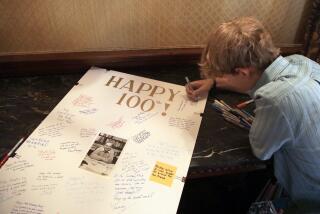Crowd Awed by Legendary Scientist
- Share via
NORTHRIDGE — In the still-dark auditorium, before renowned scientist Francis Crick had to endure the crush of attention he has spent much of his life avoiding, the Nobel laureate was speaking with quiet animation about a recent discovery that came quite literally from his heart.
Since quintuple bypass surgery, “my moods are more variable,” the man who revealed the chemical framework of life whispered with wonder. “I’m told this is not uncommon, but I don’t understand why.”
Before he could seriously ponder this question, though, the doors opened, the stage lights went up, and the 80-year-old Crick was thrust into the very strange role of scientific genius-cum-pop icon, forever a star for having identified the double-helix structure of DNA.
At Cal State Northridge to deliver a rare speech, one of the world’s most famous and most private scientists--who gets paid these days to sit and think--would have precious few moments the rest of the day to consider the implications of the double helix, the nature of human consciousness or the neurotransmitters influencing his own state of mind.
But the adulation, he admitted, “is kind of relaxing.”
Science teachers and students--breeds not widely known for pursuing celebrities--descended on Crick as soon as they spotted him near the front of the auditorium. And the line of autograph seekers quickly grew into the hundreds.
One girl had him sign a $1 bill. Others asked for two autographs, “pleeeeease.”
Leli The, a 22-year-old chemistry student at Glendale Community College, placed a plastic box containing a fruit-fly experiment on the floor and pulled out a textbook protected with a handmade, cloth cover. She opened it and asked Crick to sign his name next to the famous photograph of himself and James Watson, co-discoverer of the double helix.
“Now you must find Watson,” Crick said in his perfectly clipped accent, his impressive eyebrows rising.
“He’s a legend,” the grinning The said a moment later of Crick.
So is the story of how Crick and Watson made the discovery that brought us both a mind-boggling scientific campaign to map the human genome and the movie “Jurassic Park,” both genetically engineered tomatoes and drugs, and a good portion of the blood evidence in the trials of O.J. Simpson.
Crick was 36 and Watson just 23 when, in 1953, the two published a remarkably brief article in the journal Nature. In 900 words, they proposed that deoxyribonucleic acid, or DNA, had a double-helical structure.
And little has been the same since.
“I might need another pen,” Crick said with half the autograph seekers left to go.
A research professor at the Salk Institute for Biological studies in La Jolla, Crick has spent recent years turning his formidable mind on itself in an attempt to explain consciousness, or the human “soul”--in the end, just a glob of neurons in the skull, he contends.
And he spoke for an hour Thursday on how humans and monkeys see, and how a better understanding of sight may provide clues about the elusive concepts of consciousness and free will.
And then, trailed by hundreds, he moved to a nearby room where another line quickly formed and fans queued up to have more formal portraits taken, shaking hands with the Man Who Changed the World.
“It’s definitely hero worship,” said Bill Tarr, a high school science teacher.
Before the worshiping began, though, back in the dark auditorium, it was clear that 44 years after he solved one of the great mysteries of the universe, Crick was still full of wonder.
When told about another man who recently had open heart surgery, Crick’s eyes opened wide and he asked if this man had the same strange mood swings.
Yes, came the answer.
Crick nodded his head. Then he shook his head.
“I’m not sure of the physiological reason for it,” he said.
He looked as if that would bother him until he found an answer.
More to Read
Sign up for Essential California
The most important California stories and recommendations in your inbox every morning.
You may occasionally receive promotional content from the Los Angeles Times.













